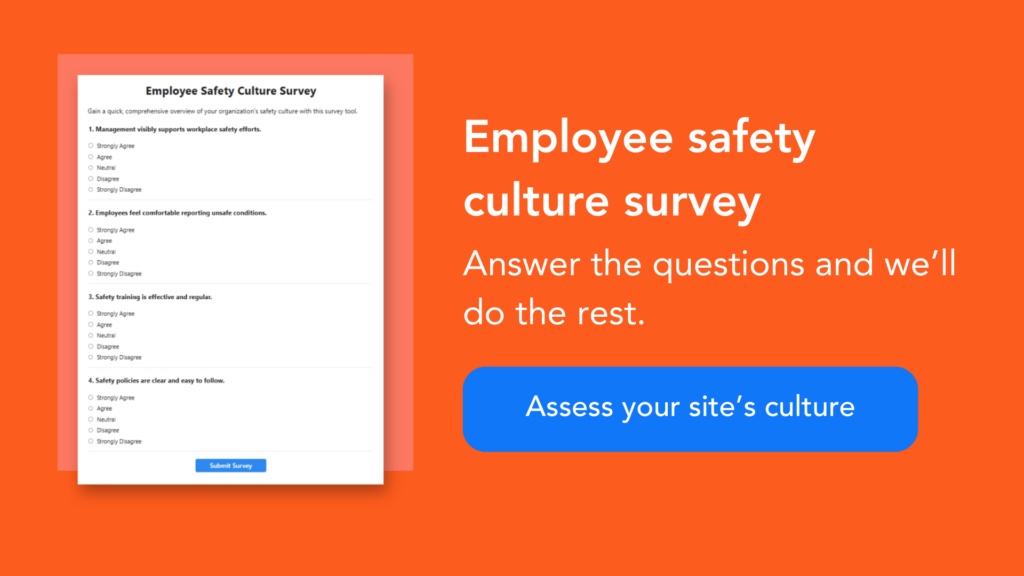According to the National Safety Council, workplace injuries cost employers an estimated $167 billion in 2021 alone. And this figure doesn’t even include the millions of days of productivity lost due to injured employees being unable to come to work.
If you want to reduce these costs, you first need to improve safety culture in the workplace. This means implementing an active strategy for preventing injuries/accidents and getting the buy-in of workers at all levels of your business.
What is safety culture?
An organization’s safety culture exists when employees at all levels share the goal to protect everyone from safety and health hazards. In other words, it is the business’ approach to safety in the workplace.
This set of shared standards and practices comes from the top down. To have a thriving, safe work environment, frontline workers must feel as strongly about staying safe as leaders do about keeping them safe.
While each organization has a different approach to safety, not all approaches are necessarily good. Leaders who consistently reward productivity, for example, can unintentionally send the message that being fast is better than staying safe. Creating a great safety culture depends on small actions and communications that ultimately shape the beliefs and habits that your employees adopt.
Why is safety culture important?
Your organization’s safety culture is important because it impacts the probability of accidents, injuries, and deaths from happening. A 2009 research study from the Institution of Occupational Safety and Health (IOSH) found that:
“Employees’ perceptions of and attitudes towards safety [are] independently associated with individual safety performance and wellbeing.”
One of the most notable qualities of a poor safety culture is a disconnect between how different stakeholders in the company approach safety. If only leadership or only frontline employees practice safe habits in the workplace, this means that not everyone is on the same page. And the result of this disconnect is inconsistent safety practices which lead to accidents.
Here are some of the other tell-tale signs of a poor safety culture:
- Widespread safety rule noncompliance
- Frequent OSHA citations
- An experience modification rate (EMR) that is greater than 1.0 (meaning that you have elevated workers’ compensation insurance costs)
- Inability to obtain contracts due to safety programs and company loss experience
- Failure to comply with the company’s safety procedures
- Leadership emphasis on production or cost before safety
To create a strong safety culture, you need to align the values of people at all levels within your organization. This comes down to how both leaders and employees approach safety every day.
Leaders improving the culture
Senior management should be actively involved with employee health and safety. Leaders must commit to creating safe work environments that are free from recognizable hazards. They do this by establishing goals, monitoring safety performance, and holding workers accountable to company standards.
Managers and supervisors implement accident and incident prevention measures which ensure employee compliance with safety rules, programs, and procedures.
Employees contributing to the culture
Employee participation in safety initiatives and routines is critical for overall success. Widespread participation in a safety program can help identify hazards and lead to solutions that ensure safety in the workplace.
Each person is responsible to ensure they comply with safety rules, programs, and procedures. Getting your workers to commit to these initiatives is the only way that you can reduce all of the costs associated with injuries and accidents.
Tips to improve safety culture
Regardless of your approach to safety, communication is key. But talking about safety isn’t enough on its own. Your actions ultimately determine how others will approach safety. Cutting corners, neglecting maintenance, and praising productivity are just some ways that leaders may unintentionally promote a poor safety culture.
Below are elevent tips to help you improve the safety culture within your company. Implement as many as you can for the best outcome.
TIP #1: Ask the right questions.
Employees are key to obtaining useful information about success and adherence to safety programs. They are excellent resources for learning more about the company’s current safety culture and areas of improvement.
Whether through weekly GEMBA walks, one-on-one interactions, or group brainstorms, make sure you get your employees’ input on how to improve. Companies with the best safety performance value and implement the input of their frontline workers.
TIP #2: Look for employee leaders within your organization.
Informal leaders have the respect of their fellow employees. Find people who have influence over their peers within the workplace. Ask these leaders to join a safety committee and take part in safety initiatives like hazard assessments and 5S audits.
TIP #3: Perform a risk/hazard assessment.
A hazard assessment is an evaluation of a workplace that focuses on finding safety hazards. Per OSHA recommendations, “an effective program systematically identifies, evaluates, and prevents or controls general workplace hazards, specific job hazards, and those potential hazards which may arise from foreseeable conditions.”
TIP #4: Perform a gap analysis.
Check OSHA’s requirements for safety programs and required training. Your hazard assessment and the resources on OSHA’s website will help you find deficiencies in your overall safety program. Download the Existing Standards Crosswalk to discover the standards your business is subject to.
TIP #5: Analyze accident history.
Look up the Bureau of Labor Statistics’ (BLS) annual injury reports for injury expenses and lost time data for your industry for the previous five years. Compare your annual 300A reports to the BLS data. Utilize your workers’ compensation provider to analyze accident data looking for trends. Ask your provider to supply your annual Experience Modification Rate (EMR) for the last five years. Is the EMR going up or down? Your goal should be an EMR less than 1.0.
TIP #6: Analyze past OSHA and regulatory citations.
Find if any OSHA citations have been permanently addressed. If not, fix the equipment or reimplement the relevant safety program. Inspection and citation data can be found here.
TIP #7: Form a working safety committee.
Your committee should consist of managers, supervisors, and hourly employees. Give the committee time and money to address identified safety deficiencies. And make sure the committee meets consistently. Consider making these fun safety meetings by doing icebreakers and other team-building exercises.
Frontline employees will be excited to share their insights and suggestions. If you regularly cancel the safety committee meetings, you will send a message that you don’t care about protecting workers. To improve the safety culture, you have to talk about safety on a regular basis–not just every once in a while.
TIP #8: Implement a safety incident reporting system.
The system should include incidents like near misses, injuries, and property damage. For each incident, you should include action items to prevent the incident from happening again. If you don’t track these action items, however, your system will not be effective. Make sure you track your actions and ensure that they are implemented as soon as possible.
TIP #9: Implement a stop work procedure.
Empower employees to stop work if they or their coworkers are in danger of being injured. That way, they won’t be afraid to speak up when they see a hazard. When this happens, make sure you listen attentively and match your employee’s concern for fixing the issue right away.
TIP #10: Implement continuous improvement.
Making ongoing improvements in performance, commitment, strategy, and process all help build up the company’s bottom line and drive down near misses, property damage, and employee injuries. Consider following a PDCA (Plan Do Check Adjust) process for your improvements.
TIP #11: Recognize and celebrate safety achievements.
Recognize group or individual safety achievements regularly. This is one of the easiest ways to develop a strong safety culture in a warehouse, factory, etc. Remember, whatever you consistently talk about and focus on will set the tone for your workplace priorities. If employees hear you recognize and reward a safety mindset, they will begin to be more aware and proactive during the day. Instead of focusing on employee injuries, which are lagging indicators, celebrate safety accomplishments instead.
Stay up-to-date on safety best practices
Every year, safety accidents cost companies billions of dollars in lost productivity, injury expenses, operational repairs, and more. The best strategy to deal with these costs is to develop a strong safety culture from the top to the bottom of your organization.
Improve the safety culture at your site by staying up-to-date on best practices within your industry. Follow the Frontline blog to stay informed on everything you need to know about making your safety processes more effective and successful.





